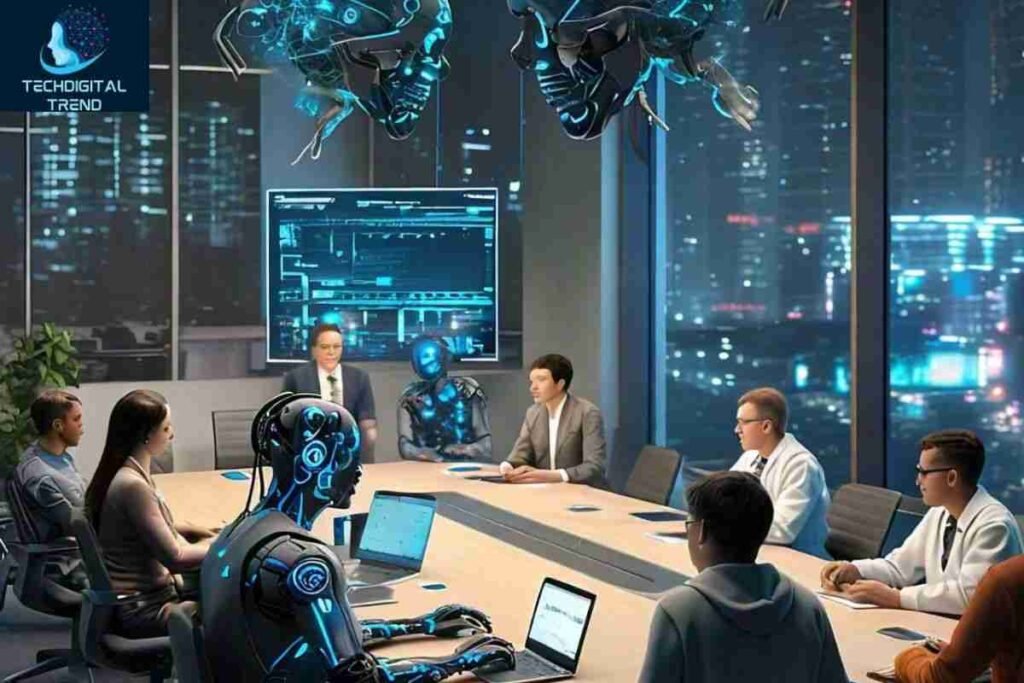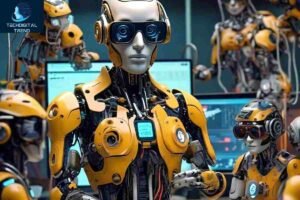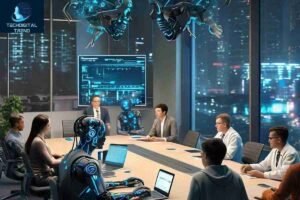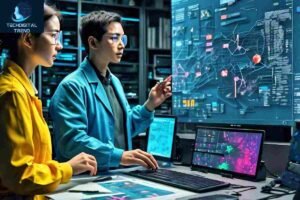Table of Contents
ToggleAI Bots: Transforming Jobs and the Future
The world has been engulfed by artificial intelligence (AI), which is changing industries and our way of life and work. The creation of AI bots is one of the biggest developments in AI technology. These clever computer programs are made to communicate with humans, carry out automatic activities, and simulate human behavior. But as AI bots advance in sophistication, it becomes crucial to consider whether or not they may eventually replace human labor. This extensive blog post will look at how AI bots are affecting the workforce, which industries are most impacted, and what the future holds for human labor in an AI-driven society.
What Are Artificial Intelligence Bots?
Artificial intelligence (AI) bots, often referred to as chatbots or intelligent agents, are computer programs that employ AI to carry out activities on their own. They can handle user input in normal language and are meant to mimic human communication. Machine learning algorithms provide AI bots the ability to learn from encounters and get better over time.
The Impact of AI Bots on the Workforce
Enhancing Efficiency and Productivity
The capacity of Artificial intelligence bots to automate monotonous jobs boosts productivity and efficiency, which is one of its main benefits. Artificial intelligence (AI) bots are utilized in numerous sectors to do repetitive and time-consuming activities including data input, scheduling, and customer service. Businesses may free up human workers to concentrate on more intricate and significant responsibilities by automating these operations.
Reducing Operational Costs
Businesses may save a lot of money on operating expenses by using Artificial intelligence bots. Businesses may save labor expenses and improve resource allocation by automating repetitive processes. Furthermore, AI bots don’t require breaks and may work around the clock, guaranteeing consistent output and service availability.
Improving Customer Service
AI chatbots, which offer real-time assistance and customized conversations, have completely transformed customer service. For instance, chatbots can respond to consumer questions, fix problems, and provide product suggestions. AI bots can provide customized solutions and improve the consumer experience overall because of their rapid processing of vast amounts of data.
Industries Most Affected by AI Bots
Healthcare
AI bots are revolutionizing patient care and administrative procedures in the healthcare sector. Virtual nurses and medical assistants can help with appointment scheduling, prescription reminders, and vital sign monitoring for patients. Furthermore, medical data and photos may be analyzed by AI-powered diagnostic technologies, which help medical personnel make precise diagnoses.
Retail
Artificial intelligence bots have been adopted by the retail sector to improve the shopping experience. Virtual shopping assistants can expedite online transactions, offer tailored recommendations, and aid clients in finding items. In order to help shops effectively satisfy client requests, AI bots are being utilized for supply chain optimization, demand forecasting, and inventory management.
Finance
Artificial intelligence bots are enhancing client relations and optimizing processes in the finance sector. For instance, computerized investing advice based on personal preferences and market trends is offered by robo-advisors. AI bots may also handle transactions, identify fraudulent activity, and help with regulatory and compliance work.
Manufacturing
The use of AI bots has significantly advanced the industrial sector. Production line optimization, quality assurance, and predictive maintenance are applications for these bots. Artificial intelligence (AI) bots may anticipate equipment breakdowns and suggest maintenance plans by evaluating data from sensors and machines. This reduces downtime and increases productivity.
Education
By offering individualized learning experiences, AI bots are starting to have an impact in the educational field. Intelligent tutoring systems can evaluate students’ areas of strength and weakness, provide individualized course materials, and give immediate feedback. AI bots can also help with administrative duties like handling student information and assignment grading.
Challenges and Concerns
Job Displacement
Concerns about AI bots‘ ability to replace human workers top the list of worries. Concern over the potential replacement of human labor by automated systems is rising as AI technology develops. Automation is especially dangerous for jobs that need repeated and regular activities. But it’s also critical to understand that AI bots have the potential to generate new sectors, jobs, and positions.
Skills Gap
The integration of AI bots into the workforce requires a new set of skills. Workers must adapt to the changing landscape by acquiring knowledge in AI, machine learning, and data analysis. Bridging the skills gap is crucial to ensuring that employees can work alongside AI bots and leverage their capabilities effectively.
Data Privacy and Security
AI bots rely on vast amounts of data to function effectively. This reliance raises concerns about data privacy and security. Businesses need to implement robust data protection measures and comply with regulatory standards to safeguard sensitive information.
Ethical Considerations
There are ethical questions raised by the use of AI bots. Accountability, transparency, and algorithmic bias are issues. To guarantee that AI technology is utilized responsibly and ethically, businesses and legislators must address these ethical concerns.
The Future of Work in an AI-Driven World
Collaboration Between Humans and AI Bots
Rather than viewing AI bots as a threat to human jobs, seeing them as collaborative partners is more productive. AI bots can handle repetitive and mundane tasks, allowing human workers to focus on creative, strategic, and complex activities. The future of work lies in the seamless collaboration between humans and AI bots, leveraging the strengths of both to achieve optimal outcomes.
Upskilling and Reskilling the Workforce
To thrive in an AI-driven world, investing in upskilling and reskilling the workforce is essential. Workers must acquire new skills that complement AI technology, such as data analysis, programming, and problem-solving. Lifelong learning and continuous professional development will be key to staying relevant and competitive in the job market.
Creating New Job Opportunities
Artificial intelligence (AI) bots have the ability to create new employment as well as replace some existing ones. Skilled individuals are needed for the creation, deployment, and upkeep of AI systems. Furthermore, new sectors and creative work categories may emerge as a result of AI bots‘ enhanced productivity and efficiency.
Regulatory and Policy Considerations
It is crucial to create legislative frameworks and laws that address the effects of Artificial intelligence bots as they become more commonplace in the workforce. To guarantee the equitable and moral application of AI technology, governments, and legislators must collaborate to develop regulations. This involves resolving concerns about algorithmic transparency, data privacy, and employment displacement.
Conclusion
Without question, Artificial intelligence bots are changing how we live and work. Even though they provide many advantages, such as more productivity, cost savings, and better customer service, they can present significant difficulties and worries. Companies, employees, and legislators need to overcome these obstacles to properly utilize Artificial intelligence bots’ potential. Artificial intelligence bots and human laborers may live in harmony and spur innovation and prosperity in the future if we embrace cooperation, invest in upskilling, and set ethical standards.
Open this link: Tap to here















